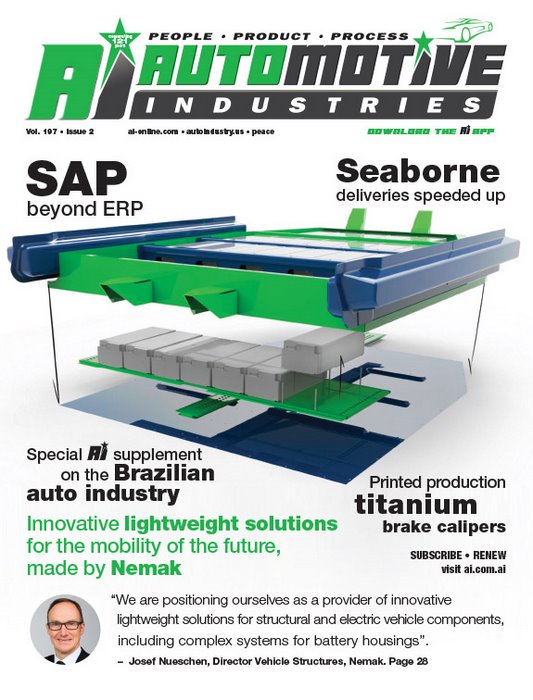
A key to anticipate the needs of the customers and to meet the complex engineering challenges are multi-material and multi-process solutions.
The global automotive industry is in the midst of profound transformation. On the background of increasingly stringent environmental regulations, alternative propulsion systems – particularly electric powertrains – are gaining more and more ground.
Analysts predict that fully electrics, together with hybrid vehicles, will represent between 15% and 25% of the total market by 2025.
Both propulsion types, hybrid and pure electric, have one thing in common: the battery systems are of paramount importance.
This is where Nemak comes into play. Over the last 40 years, the company has driven the aluminum lightweight trend to become a leading supplier in the powertrain segment composed of cylinder heads, engine blocks, and transmission cases.
During the last few years, Nemak additionally scaled up successfully a business line dedicated to structural components as customers pursue further weight reduction in large structural castings. Important strategic decision basis for positioning Following this path, in 2017 Nemak made the strategic decision to integrate the competencies of this business line in its new structural components and electric vehicle business area, offering cutting-edge innovations in vehicle lightweight, primarily in body-in-white and chassis applications.
With this decision, Nemak additionally positions itself as a provider of innovative lightweight solutions related to hybrid and electric powertrains, especially for battery housings and e-engine housings. Already in 2017, the SOP of Nemak’s first battery solution for a PHEV (plug-in hybrid electric vehicle) of a German OEM became the new business area’s first success. The 0.90m x 0.50m component was one the first battery housings produced as a single cast component with a 4.400-ton High Pressure Die Casting (HPDC machine). By end of 2018, the SOP for an even more complex PHEV battery housing of another German OEM will take place.
The huge component consists of four single units which will be joined by friction stir welding. Finally, this project provides a first insight how the company is transforming to a provider for innovative and also integrated lightweight solutions. For sure, the basis for Nemak’s positioning as a solution provider is, on the one hand, the proven know-how and the outstanding capability regarding every type of casting technology as well as its expertise in secondary processes.
Based on this, the company is able to offer a wide range of design concepts, from multi-piece HPDC to highly integrated one-piece components made in Precision Sand (CPS®) or Low Pressure Die Casting (LPDC). On the other hand, Nemak has also rapidly developed new competencies in the areas of design and engineering as well as extrusion and sheet metal forming processes. In addition, know-how in assembly technologies such as thermal and nonthermal joining has been built up.
The latest PHEV battery housing project illustrates how the company is able to use manufacturing technologies in combination with different joining techniques to integrate different types of material into the component. This capability is essential for also playing a role in the market of battery systems for fully electric vehicles.
The right material in the right place
Besides new customer requirements, e.g. traced back to stringent range targets, battery solutions for fully electric vehicles,
constitute complex engineering challenges, including structural demands regarding crashworthiness, stiffness to increase safety,
and NVH requirements to increase comfort.
Nemak takes this as an opportunity, offering innovative lightweight solutions by considering multi-material and multiprocess approaches within novel concepts and designs. Based on a combination of former and newly gained competencies, an
innovative modular battery structure concept has been developed and for the first time presented at the Euroguss 2018, the leading trade fair for the die casting industry.
Due to its multi-material and multi-process design approach, the professional audience highly valued this concept. The use of flexible material allows Nemak to introduce the right material in the right place.
The design of the modular battery structure concept tackles the thermal challenges arising from the electrical requirements
of such a product. Nemak’s innovative thermal management concept is integrated within a two-stage impact absorption
system, made of aluminum extrusion and sheet metal formed components. The concept is designed to additionally cope with
the crashworthiness demands acting from the bottom and side of the battery structure. Moreover, maintenance challenges that
arise from the requirement to exchange battery cells are gaining more and more attention. The service-oriented solution presented at the Euroguss is meeting also this requirement and can thus be considered as a state of the art application – supported by the utilization of thermal and non-thermal joining technologies.
Due to the developed and already proven competencies regarding design, engineering, construction, and production of complex components for electrified vehicles, Nemak is now cooperating intensively with leading players of the automotive industry. Following its strategic path, the company is preparing the facilities within its global footprint to meet also future requirements of its customers to further drive the transformation of Nemak from a casting expert to an innovative provider of lightweight solution
for the mobility of the future.













More Stories
Some Ways How Motorists End Up in Collisions at U-Turns
Maximise Margins with Proven PPF Tactics
Finding the Car Boot Release Button – Tips and Tricks